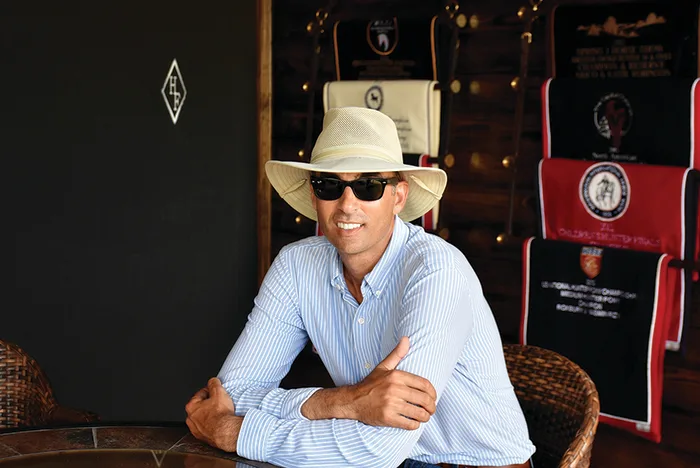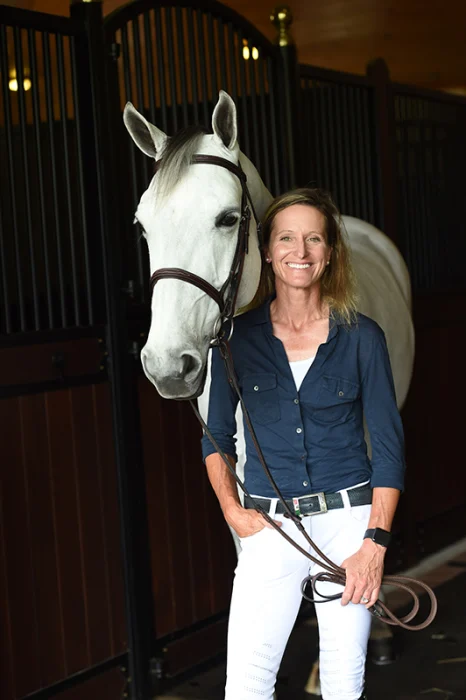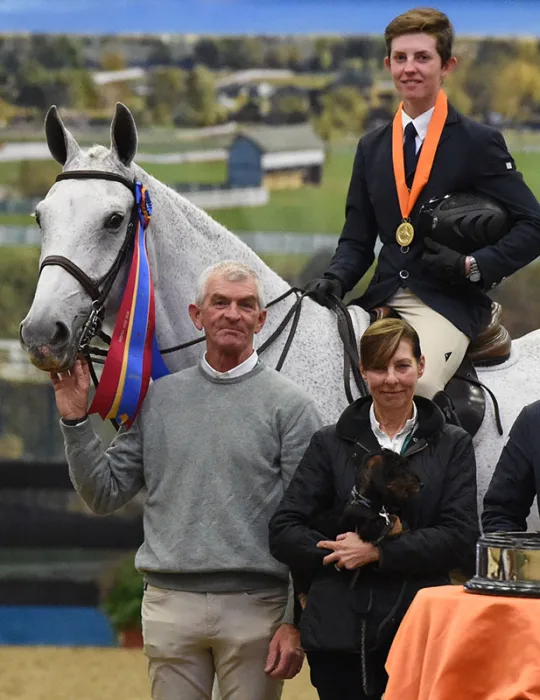Every rider can relate to the feeling of looking at a jump and seeing nothing—no hunter gap, no quiet spot, just nothing. Some people are blessed with natural ability in this arena, but is there hope for the rest of us? We talked to top hunter, jumper and equitation trainers about their methods for helping students who are struggling with their eye.
Andre Dignelli
We do a lot of cavaletti; that’s something that’s always a part of our set-up in our ring. We do a lot of stride control exercises, and those are done daily. We can do them with the cavaletti on the ground or flipped up a little higher. We set two, and then we’ll do four, five or six strides. We change up the striding every way we can think of doing, so they’re practicing their timing and their rhythm all the time.
If people are having trouble finding their way to the jump, I think a lot of the time it’s because they aren’t riding enough and aren’t practicing enough. We really try to instill a work ethic and make sure they’re putting enough hours in the saddle with lots of little jumps and poles that simulate the patterns they’re going to see in the ring or are more difficult than what they’ll see in the ring. Half the time people lose their way trying to find the jump because they’re nervous or don’t feel prepared, so we try to make sure they really feel like they’ve done their homework. We don’t talk a lot about finding a good distance; that’s much less of the emphasis.

As far as where you look when you’re approaching a jump, I’ve heard people say, “Don’t look at the jump,” and that’s just the craziest thing I’ve ever heard. When I’m cantering to a jump I’m staring right at it, and when I know where I’m at, then I’m starting to look beyond it, but that whole idea of not looking at the jump makes no sense to me. You stare at that jump until you know where you’re at.
If I have a student who is struggling seeing the jumps, the key is practicing at a very low height. You can jump a lot of little jumps or cavaletti and poles daily, so they can get that practice without putting the horse at risk or overtaxing them.
Jim Hagman
The question of teaching someone to find a distance, it’s such a process-oriented thing. It starts with our school horses; they all have to have a really good rhythm. They may be some choppy Quarter-Arab mix, but they all have great rhythm.
From there it’s all about the rider’s position. From short stirrup riders all the way up, they’ve got to have their shoulders over their hips; their back over their heels; they’ve got to be behind the pommel. Because when you get over the pommel you get ahead of your horse’s motion: You’re not with the horse; you don’t know where you are.
ADVERTISEMENT

I always tell my riders to ride the back feet and let the front feet get to the jump. As an exercise, I like to put a small fence parallel to the rail, like four strides off the rail, so it’s not very far, and they have to ride a square turn to it. It’s basically like a quarter turn on the haunches, and the back legs get under them leaving the turn. It’s such a short space that if they turn correctly, they just find the distance, and I’ll have them do that over and over again. It can be a tiny crossrail; it doesn’t need to be a big fence.
It’s super vital when you have people who are struggling that they ride horses who one, want to jump, but two, they have a very regulated canter; they always carry a good rhythm. More than anything that’s going to help teach them to carry a good pace and be in tune with their horse and know where they are.
Molly Ashe Cawley
What’s the secret to finding the jumps? I’m still trying to figure that out myself sometimes! My approach may be a little different than the standard approach. The biggest thing that I tell people is to stop worrying so much about the distance, and just ride the turn. It’s funny, when you stop looking at it and focus on riding your turn well it seems to just appear!
People will be nervous about their eye, so they’re just staring at the jump through the turn, trying to see the distance from too far away, and as they’re desperately looking for it they’re changing the canter and pulling and kicking, and the next thing they know the horse isn’t with them anymore. They’ve adjusted their canter so much they aren’t going to see anything out of stride. What I tell my students when they’re having trouble is to forget about the distance and just really focus on what’s happening underneath you and maintaining one canter through the turn and riding the turn. Then the jump will take care of itself.

I like to set up canter poles on a circle where, if you stay in the middle and turn correctly you can fit a whole stride, but if you cut in it gets too short. I’ll put four or five poles on one part of the circle, about a third of the circle, and you start to feel if your horse is drifting out or cutting in, and you start fixing that. Once they have that down I’ll maybe set three poles out and have them do a four to a four, a five to a five, and they’ll start to realize if they only worry about finding a distance to that first pole and not what kind of canter they have and regulating their stride the second part won’t work out.
Throwing everything out the window because you think you saw a distance is not going to help you most of the time. One of the best pieces of advice I can offer is worry less about the distance and more about what’s happening underneath you, and you’d be shocked at how easily you see a distance.
Missy Clark
How do I help students find the fences? That’s a challenging one in a lot of respects, because I am a firm believer that God decides who he is going to bestow that natural ability upon, but we can certainly work on it with our students.
ADVERTISEMENT
We will often set some gymnastic type lines for our riders where it’s a set striding in between distances to start, and then we can vary it as the riders get a little bit better, where they can practice doing five strides and then six in the same line. Then the next step might be to make a bending line and have the riders do varying strides in the same line, so they begin to understand where they are in a line.
It really blows my mind when people tell their students not to look at the jump. That would be like getting in the car and not looking at the road. I mean, how else do you measure where you’re at? I scratch my head at that, to be honest. You look at the jump, and you measure it. If you have a horse with a pronounced drift to the left, I might possibly tell the rider to put their eye a little right of center on the fence while turning the corner on the right lead, which might help to compensate for their horse’s drift.

When I have someone who is really struggling I always try to focus first on pace. I often tell riders that their odds of making a mistake at the jump are going to increase if they’re not working up to pace. Additionally, in those moments when riders might not know where they are in relation to the jump and they’re tempted to make some big move, I tell them to try and stay at the same pace: Don’t speed up, don’t slow down. I think one of the biggest mistakes a rider can make when they don’t see a distance is to make a big move trying to leave the stride out at the last moment.
Hope Glynn
I often tell students they’re working too hard trying to find distances. I tell them not to look from too far back. You sometimes get beginner to intermediate riders who are so focused on finding a distance that they don’t focus on rhythm and straightness, and that will help you find a distance much better than trying to work on your eye. If you can find a good, balanced canter usually two to three strides out, the distance will show up.
Too many people tell beginners they need to create something and find a distance, and that’s where they start adding out of the turn, or they feel they have to do some big move, when if they just rode their rhythm they wouldn’t have to change anything. The biggest thing I remind them is if you’re making a dramatic change six strides away you’re making the wrong decision. You get in trouble when you have a major pace change and really pull or kick five strides away. I’m much more of a teacher of pace and straightness than I am of finding a specific distance.
Is your horse crooked? Are they speeding up? Are they slowing down? Don’t get stuck looking for something. A lot can change in the six strides before a jump.

We do a ton of bending lines and learning how your track affects your distance and really feeling where your horse is at underneath you when you’re riding the outside arc or the direct route. I’ll have riders with their eye on the middle of the fence looking for that distance, and they can’t figure out why they were two feet too long, and it’s because their horse is crooked and jumping three feet off the center of the fence. They need to focus on the fact their horse wasn’t straight, because the distance wasn’t off; they were off their line.
This article appeared in the March 25 & April 1, 2019, issue of The Chronicle of the Horse. You can subscribe and get online access to a digital version and then enjoy a year of The Chronicle of the Horse and our lifestyle publication, Untacked. If you’re just following COTH online, you’re missing so much great unique content. Each print issue of the Chronicle is full of in-depth competition news, fascinating features, probing looks at issues within the sports of hunter/jumper, eventing and dressage, and stunning photography.














